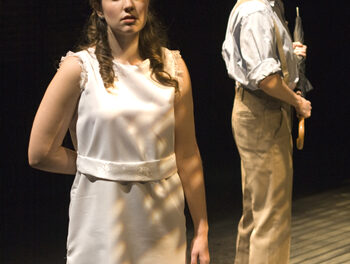Arts NC State’s University Theatre program took an ambitious plunge with the staging of You Can’t Take It with You, George S. Kaufman and Moss Hart’s classic American comedic drama. Written, first produced, and set in 1936, with America still mired in the Great Depression, this is a work that has survived much of its somewhat anachronistic precepts and continues to be a favorite of audiences. The very lovely Titmus Theatre in the Frank Thompson Hall on the NC State campus is the perfect venue for this larger-than-life expansive production that employs nineteen actors!
Most popular movies, plays, and live shows of the 1930s tried to give their audiences a respite from their harsh lives and financial problems, and You Can’t Take It with You was no exception. While a major part of the plot deals with class differences and attitudes toward government intervention in its people’s lives, it is mostly a large set of eccentric characters, mismatched expectations, and fast, clipped dialogue that has made this such a big hit for more than 70 years. In fact, its style gave birth to an entire genre of TV sitcoms that often seem to be using the same cookie cutter.
While waiting for the show to begin, we were able to enjoy what may have been the biggest star of the entire production: the fabulous, period-correct, and lush set. Titmus Theatre is much wider than deep (only 8 rows, with about 35 seats across), so the stage is quite large. Scenic designer David Jensen gave us an impeccable, realistic living room of an upper-middle class family with furniture of the era and construction that looked, well, like a real house. No expense appeared to be spared and a big buck Broadway production would envy this set.
There was a brief introduction by an administrator of University Theatre who reminded us that not only is the entire cast student actors, but the University itself does not have a major in theatre. I’m not sure of what the intent behind that statement was, but, for me, that did have some effect on my perception of the performance. More on that later.
The first act has the important and difficult task, considering so many characters, of introducing us to the members of the Sycamore household and their friends. All are afflicted with their own particular brand of kookiness so that it seems that “normal” is about the worst thing that one can be. There is the matriarch, Penelope (Paulina Ragunas), who constantly writes bad plays; her daughter, Essie (Molly Riddick), who dances instead of walks; and Essie’s husband, Ed (Danny Beckman), who mostly putters around with a printing press and plays the xylophone. The patriarch of the household is Grandpa Vanderhof (Nat Conti), retired for 35 years, who keeps snakes and refuses to pay federal income tax. The gist of the story is that Alice, the “normal” daughter, is to be engaged to Tony Kirby, a vice president of the company at which they both work, and son of the owner, a wealthy Wall Street type. Getting the families together for a dinner and all the hilarious misperceptions and misadventures that ensue (yes, I’m being somewhat sarcastic) is what the remainder of the play is about – in a nutshell.
There are an enormous number of entrances and exits, simultaneous conversations, and built-in wait times for some jokes to settle, and director John C. McIlwee gave us a sharp and finely tuned ensemble, especially considering the amateur status of the cast. As equally resplendent as the set itself was the costume and hair design by Adrianne McKenzie, who outfitted the cast in an authentic 1930s feel that added to the realism of the period. I had some issues with Rachel Klem’s (dialect coach) over-the-top stereotypes of ethnic accents. Do we still really believe that all Italians say, “How-a do-a you-a do-a? It’s-a very-a nice-a to-a meet-a you-a,” as the character Mr. De Pinna (Michael Taylor) spoke? The Russian equivalent for Boris Kolenkhov (Andrew Enloe) was not much better. Even the maid Rheba (Sarah Thornton) sounded like a mix of a bad Southern accent and a speech defect.
It would be way too cumbersome and long-winded to try and comment on every one of the nineteen acting performances. I did not come away with the impression that any one was a particular standout — in fact, there seemed to be a sameness of style and approach. This made me think of the pre-show statement alluded to before about this being all student actors. These were all very good performances: no major flubs, all lines delivered cleanly and clearly, and, generally, with a good idea of their character. What I felt missing was simply experience. Much of it sounded studied, rehearsed, and “correct” rather than natural and flowing. I felt and heard the actors acting nearly throughout the entire play, rather than becoming or inhabiting the character. Yes, I know that’s an overused cliché, but even those can be true. An analogy to music is when a young person plays a piece technically flawlessly but it still falls on the listener as “missing something.”
This is a good, enjoyable production, but really has the potential to be a great one. Perhaps as the run progresses, confidence and even some abandon in how the parts are played will increase the illusion of theatre, which, after all, is why we go.
You Can’t Take It with You continues through Sunday, October 5. For more details on this production, please view the sidebar.












